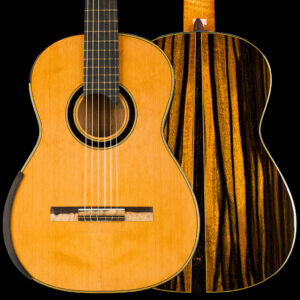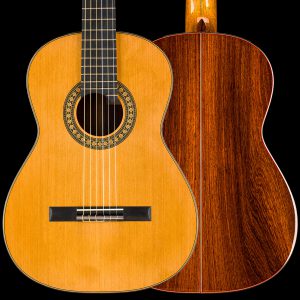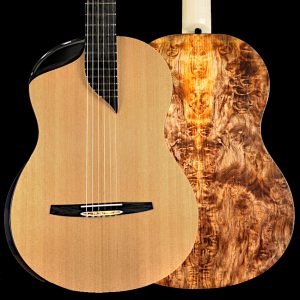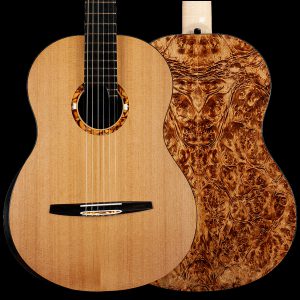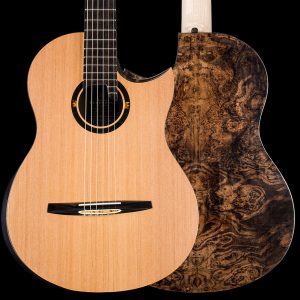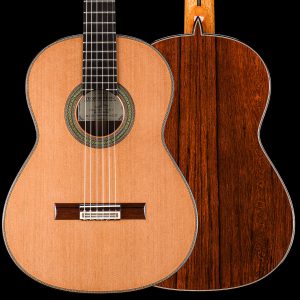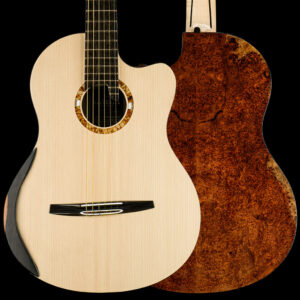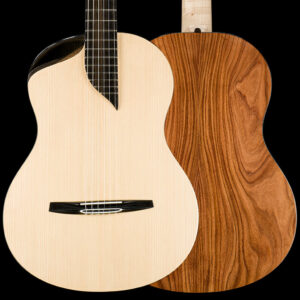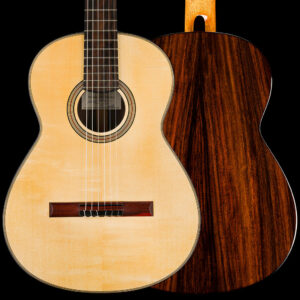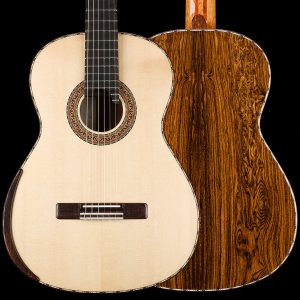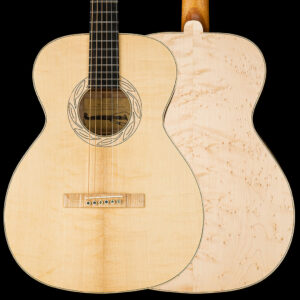Cedar or spruce?
which tonewood you prefer?
Most guitar tops are typically made of cedar or spruce, each with its own advocates and critics. Debates among guitarists about the merits and drawbacks of these materials can become quite passionate. Many players have strong preferences for one tonewood over the other, based on sound, appearance, or both. Let’s delve deeper into this widely discussed topic to broaden our understanding.
It’s important to recognize that the choice of wood and the guitar’s design significantly influence each other. However, many players tend to generalize that spruce produces a stronger and clearer sound compared to cedar, while cedar is often described as warmer and more “lyrical.” These assumptions are not necessarily accurate.
The Sound
The sound of a guitar is shaped by the luthier’s design, craftsmanship, and the choice of woods—all of which interact with each other. As John Williams once pointed out, comparing two guitars that are identical except for the top wood is a misunderstanding. A luthier must carefully consider the guitar’s top and adjust the design accordingly to optimize its sound.
In “Guitars – From the Renaissance to Rock,” it is mentioned that José Romanillos would tap on each guitar top to determine the best possible design, which then required fine-tuning by adjusting the bracing. Additionally, the quality of the wood is crucial. Even a poor-quality cut of expensive wood, such as European spruce, will not produce good sound, even for a spruce top enthusiast.
Ultimately, the most important factors are the luthier’s craftsmanship and the design that he employs and adapts to the chosen woods.
What are the fundamental differences between spruce and cedar?
Spruce is usually much lighter than cedar – has blonde, yellowish color sometimes tinted as honey. Mature spruce tends to look darker with golden tint.
Cedar has its dark amber tint from the very beginning and is easy to tell apart from spruce.
This is probably the most obvious difference between the two, but it is certainly not something to be discounted. As time goes by, a good cut of spruce will mature and darken, giving it a golden (almost glowing) look. When paired with a contrasted set of hardwoods for the back and sides, a good cut of spruce is simply delightful to the eyes of both the performer and the audience. Of course, spruce is also used with bright body woods, mainly maple.

Historically, luthiers built classical guitars almost exclusively from spruce tops for centuries. Torres, Esteso, Bouchet, Hauser, Fleta, Friederich, and virtually every other luthier of historical significance from the 19th and 20th centuries-built guitars using spruce for the tops.
The widespread use of cedar tone wood for classical guitar tops began recently, having its major “boom” in the mid 1960’s when Segovia became famous player and showed his cedar top Ramirez guitar all over the world. Also, getting good quality spruce (especially Alpine spruce) became increasingly difficult, so more and more luthiers turned to readily available cedar.
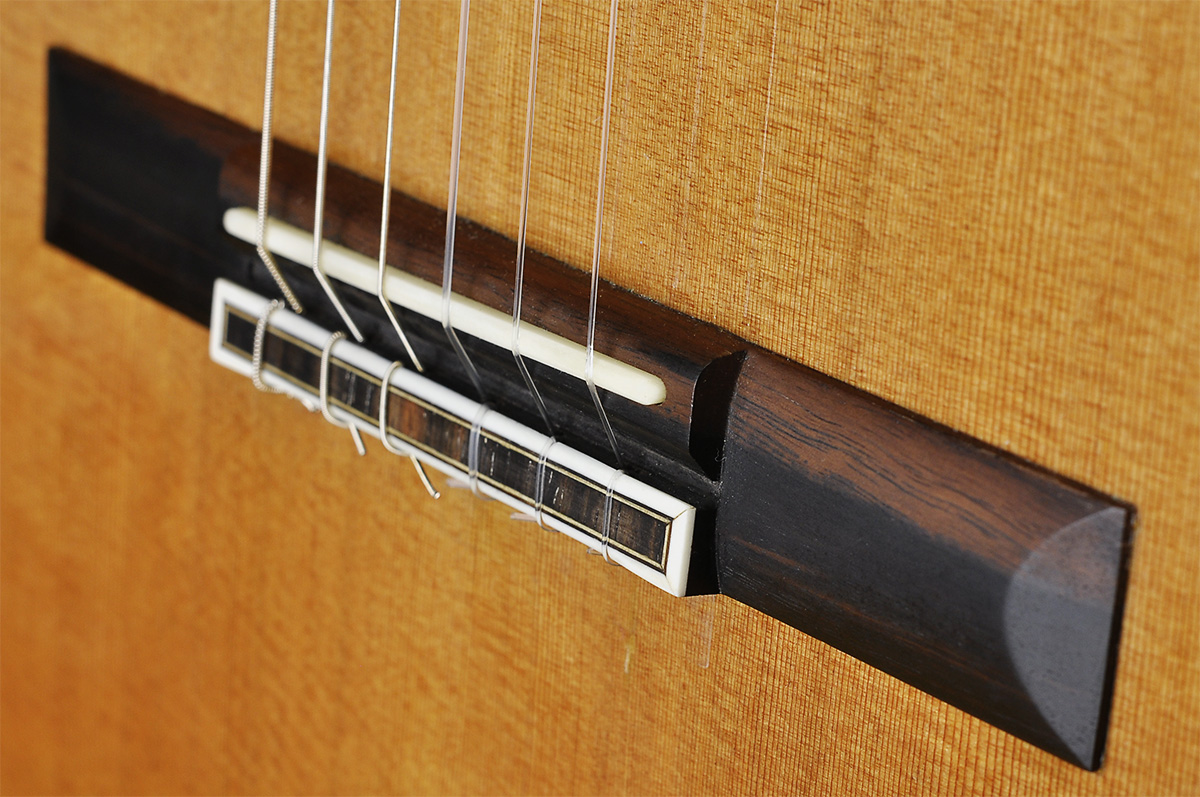
The main function of a guitar top (regardless of the material) is to vibrate. When the player plucks a guitar string, the top vibrates according to the note’s frequency, amplifying the sound produced by the natural vibration of the string and creating the guitar’s characteristic sound. That’s why it’s no surprise that hardwood doesn’t make good guitar tops as it is hard to make it to vibrate.
Spruce and cedar are very flexible but rigid materials and for this reason it has become such an appreciated and indispensable material in the construction of classical (and acoustic) guitars. Best spruce comes from trees harvested in high mountain regions as trees grow slowly at low temperatures so the yearly stripes are especially dense and narrow.
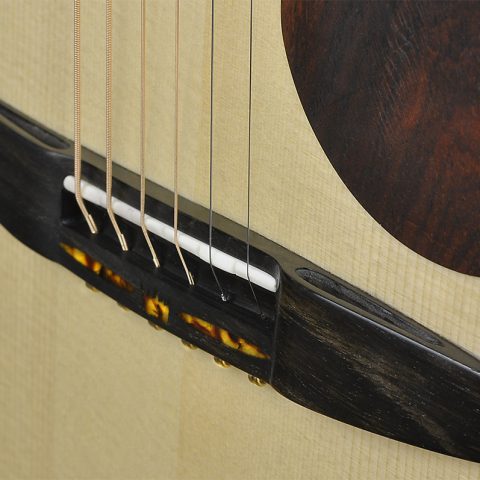
The great thing about spruce is that it ages beautifully, like fine wine (or whisky). As the top stiffens and dries with age, the sound of a spruce top guitar will slowly evolve and mature.
While the same can be said of cedar top guitars (but to less extent), there is something magically charming about the way in which a spruce top changes color over time, and how the sound produced by the instrument can reflect its age. It is believed that the sonic changes that will occur over time with a spruce top are more dramatic than those with a cedar top, so this is an attractive feature for any guitarist who wants a guitar whose sound will essentially “grow and mature” with them.
Generally, new spruce top guitar needs around 2 years of intense playing to show most of its potential. Cedar gives what it has right away – interesting feature in modern, fast-paced times.
This is perhaps the most difficult topic of this age-old debate, and it’s not surprising when you consider the myriad of variables that determine what sound a good guitar will produce.
Discounting the different techniques luthiers use to reinforce the top, or the thickness of the soundboard, it is generally accepted that a spruce top guitar will sound brighter than a cedar top guitar.
Spruce-top guitars have a wonderful blooming tone, with bell-shaped highs and lows that are low and full but tend more toward the midrange. Spruce top guitars also have a tonal palette that is responsive and highly nuanced. A guitarist with good touch will get an incredible variety of tones and timbres from a spruce top guitar. Spruce also tends to project sound in a more linear fashion, unlike cedar, which tends to “radiate” sound.
Obviously, there are a myriad of exceptions to consider. A lattice braced spruce top will sound quite different from a fan braced spruce top, and both will sound distinctly different from a double top cedar guitar. Also, the sound produced by a European spruce will sound different than a comparable Sitka spruce.
There is so much variation in the world of classical guitar and ultimately it is the player to decide what they like or don’t like about a particular tone wood. Ultimately, it all comes down to artist preference. These are just a few points to help better understand some of the more “generalized” characteristics of spruce tops.
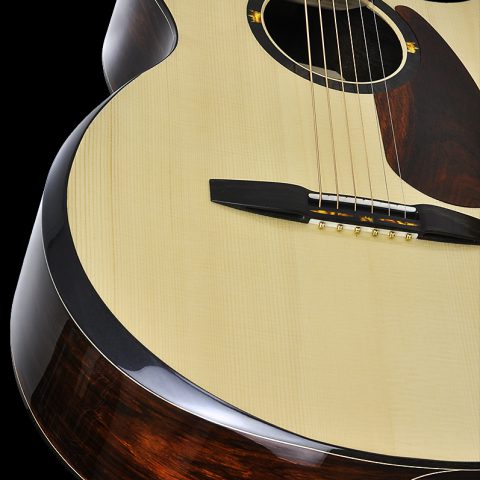
After doing vast research I came to the conclusions listed below – still with room for further examination.
Considered one of the best tone woods of all, at least, traditionally speaking. However, poor availability of high-grade cuts means that you might be better off going to an alternative with a high-quality cut. Compared to Engelmann, Alpine spruce has the same full tonal palette but is quicker with a response. Both are prized for their color and stiff lightweight.
Traphagen says about European Spruce that has “clear bell-like sound with a full tonal color pallet. With age and playing, the guitar becomes warm and rich. To me, European Spruce produces the most sophisticated tonal range of all the top woods.”
A yellowish-white wood that is softer than Sitka. Generally, it has a somewhat softer sound compared to Euro or Sitka, likely due to its increased softness. Although Engelmann logs are typically smaller, high-quality cuts are still available.
Sitka is the standard wood for steel-string guitars, largely because of its wide availability, large diameter logs, and high yields. As a result, high-grade Sitka is available regardless of the quantity used. It is also utilized in classical guitars. Generally, Sitka is stiffer and heavier than other spruce varieties, making it suitable for withstanding the high pressure and intensity of steel-string guitars. However, I have heard that Sitka also performs excellently in classical guitars if the design is appropriately matched to the wood and if a good light cutaway or light bracing is used.
Dominelli says of Lutz spruce, “What I like about Lutz spruce is this: it has the stiffness of Sitka spruce, with the light weight of Engelmann spruce. This is the dynamo combination as far as I’m concerned. Of course, not all Lutz will be of top quality; absolute statements can never be made about a species of wood. I also love Engelmann spruce.
My only problem with Engelmann is that it is often very soft, and wear is more common in Engelmann than in Sitka. Lutz spruce is probably the closest thing to good German spruce I’ve seen, except Lutz is a bit cheaper. I can’t say it’s more widely available than European spruce because very few people cut Lutz spruce for guitars.”
Regarding other spruces: I’ll have to update this when I get some comments and more information. But please let me know about Italian Spruce, Adirondack Spruce, etc.
These large diameter trees can produce excellent cuts with straight grains. The wood is generally stiff and lightweight making it great for classical guitar tops.
I build soundboards with both spruce (European and American) and cedar. I appreciate the unique qualities of each wood, and the choice depends on the player’s preference.
It’s possible to generalize between spruce and cedar if you’re comparing guitars built in the same style, for example, fan-braced cedar to fan-braced spruce. However, don’t compare a spruce fan-braced guitar to a cedar lattice or a cedar double top! Generally, it’s well agreed upon that spruce tends to sound a bit crisper, with better separation and definition, while cedar tends to be warmer and darker in sound quality. However, I’ve often heard that in blind tests, most people cannot tell them apart, suggesting that we sometimes hear what we expect to hear. Ultimately, a good guitar is a good guitar, regardless of the woods used.
Marcus Dominelli on whether spruce guitars project better:
When comparing spruce and cedar guitars built in a traditional fashion, I totally agree that spruce guitars tend to project better to the back of the hall. In my listening experience, they are more articulate and have better separation of notes most of the time. However, once you get into other modes of construction, like lattices and double tops, the game changes, and it’s harder to compare the characteristics of the two woods.
“It has been my observation that players who are used to spruce find it more to their liking; and those accustomed to cedar prefer it. Part of this seems to have to do with the sound we hope to produce. Part of it seems to be that different techniques are required to get the best sound out of each. It often takes some time to adapt the proper right-hand tracking to complement each wood. There is a tactile difference here, perhaps related to the generally faster note development in cedar.
Beyond this, the sonic differences are subtle. For many players, it is not difficult to feel the difference, but as a listener, it is easy to be fooled. In general, spruce is lighter but has a thicker, more complex sound and longer sustain. Cedar is “more powerful,” often with more headroom, and is sometimes described as “darker.” It may seem louder to the player, but in large rooms, spruce often sounds better, perhaps due to its clarity. Spruce is usually more colorful. These distinctions are subtle and not always apparent. Both woods can make great guitars. Personally, I tend to prefer European spruce, but North American spruce, particularly Adirondack and Engelmann, can be very attractive. Likewise, Coast Redwood and Port Orford Cedar can make great guitars.
What are your opinions and preferences in this matter? Leave a comment.


